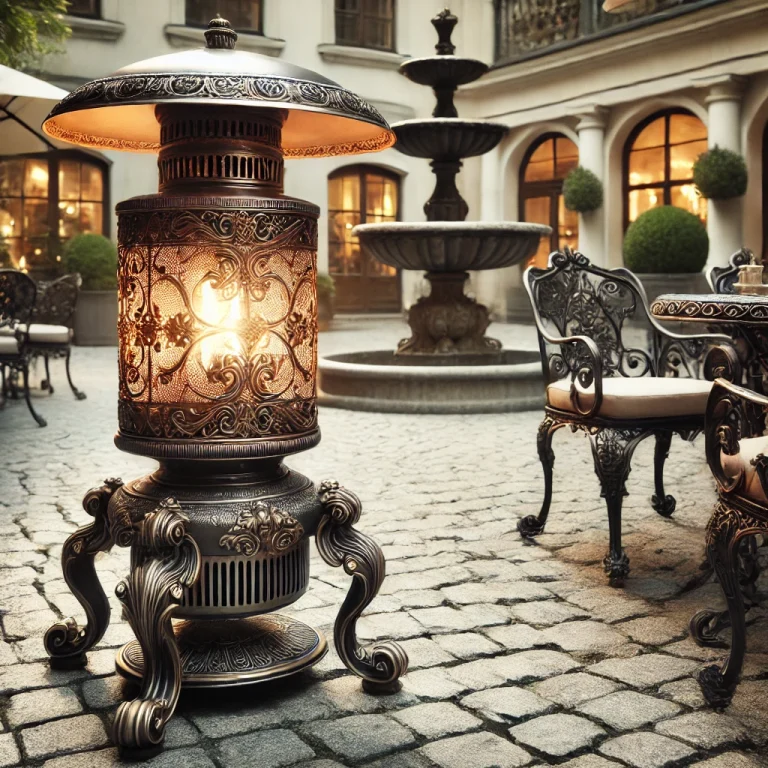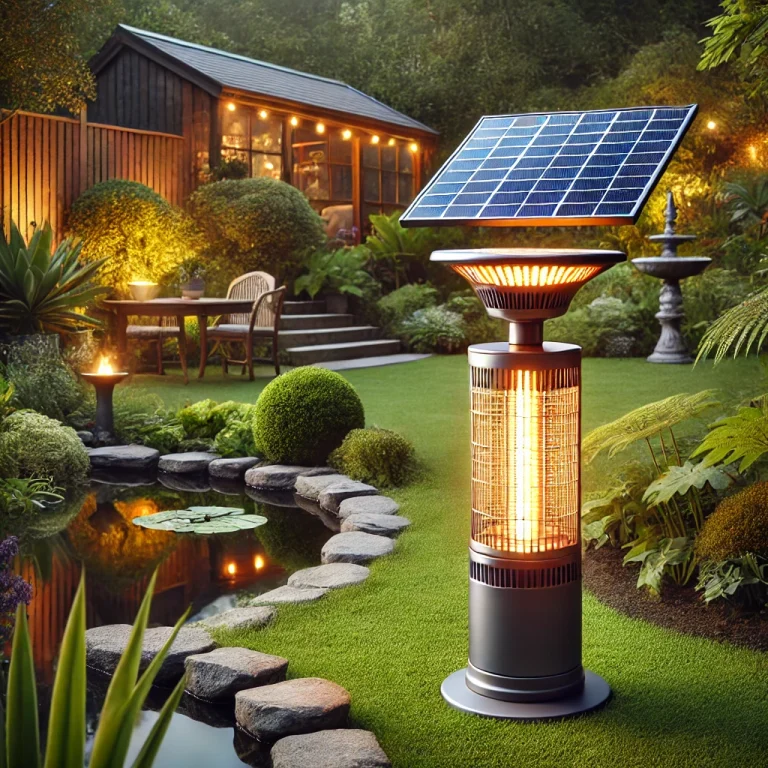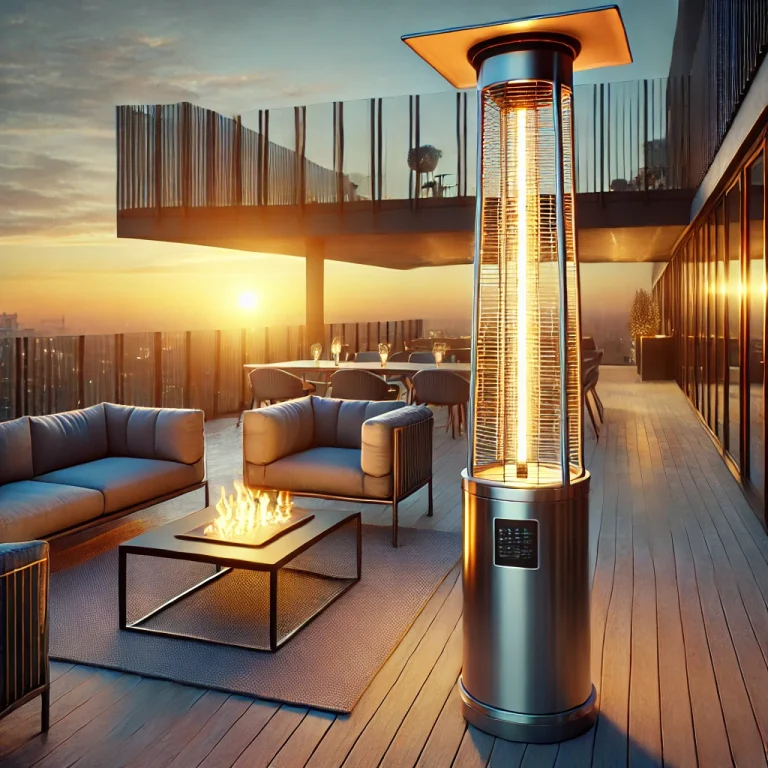Best Patio Heaters for Windy Conditions – A Comprehensive Guide to Making the Right Choice
Enjoying the outdoors shouldn’t have to stop when the temperature drops or the wind picks up. Patio heaters are an excellent way to extend the usability of your outdoor spaces, but not all heaters are made to handle windy conditions. If you live in an area prone to gusty weather, it’s essential to choose a heater designed with stability, durability, and efficiency in mind.
In this blog, we’ll dive into what makes a patio heater ideal for windy conditions, discuss key features to consider, and recommend some of the best options on the market. By the end, you’ll have all the information needed to make an informed purchase.

What Makes a Patio Heater Suitable for Windy Conditions?
When choosing a patio heater for windy areas, there are a few critical factors to evaluate:
1. Stability
Wind can easily tip over tall and lightweight heaters. A stable base, weighted design, or options to secure the heater to the ground are crucial for safety and functionality.
2. Wind Resistance
Some patio heaters feature wind-resistant burners or designs that shield the flame from gusts. This ensures consistent heat output even when conditions are less than ideal.
3. Durability
High-quality materials like stainless steel are better suited to withstand exposure to the elements, including high winds.
4. Heat Output
Wind can disperse heat quickly, so a higher BTU (British Thermal Unit) rating ensures that warmth reaches your seating area effectively.
Types of Patio Heaters for Windy Conditions
Here are the three main types of patio heaters, along with their pros and cons in windy environments:
1. Propane Patio Heaters
Propane heaters are portable, powerful, and easy to use, making them popular for outdoor spaces. Many models are designed with heavy bases or can be anchored for added stability.
Pros: High heat output, portable, quick to ignite.
Cons: Propane tanks need regular refilling, and not all models are wind-resistant.
2. Electric Patio Heaters
Electric heaters are great for smaller spaces and areas with a power source. They often use infrared technology, which provides direct and efficient heating.
Pros: Wind doesn’t affect heat output, safe for covered patios, energy-efficient.
Cons: Limited portability due to reliance on a power outlet, lower heat output compared to propane.
3. Natural Gas Patio Heaters
If you have a fixed patio area, natural gas heaters can provide a steady and cost-effective heat source. They’re often larger and sturdier than portable options.
Pros: Continuous heat supply, cost-efficient in the long run, stable installation.
Cons: Installation requires a gas line, not portable.
Features to Look for in Wind-Resistant Patio Heaters
1. Weighted or Anchorable Base
Choose a heater with a heavy base or one that allows you to secure it to the ground. Some models come with pre-drilled holes for anchoring or sandbag compartments for added weight.
2. Wind Guards
Look for patio heaters with built-in wind guards or enclosed burners. These features protect the flame and ensure consistent heat output, even in breezy conditions.
3. High BTU Rating
In windy conditions, heat can dissipate quickly. Opt for heaters with a BTU rating of 40,000 or higher to compensate for the wind.
4. Material Quality
Durable materials like stainless steel or powder-coated finishes resist corrosion and damage from strong winds, rain, or UV exposure.
5. Automatic Shutoff
For safety, many heaters come with a tilt-switch feature that automatically turns the unit off if it gets tipped over.
Top 5 Patio Heaters for Windy Conditions
Here are our top picks for patio heaters that excel in windy environments:
1. Dyna-Glo Premium Propane Patio Heater
BTU: 48,000
Key Features: Weighted base, durable stainless-steel construction, built-in safety shutoff.
Why It’s Great for Windy Areas: The Dyna-Glo’s heavy-duty base ensures stability, and its high heat output keeps you warm even in breezy conditions.
2. Bromic Heating Tungsten Smart-Heat Electric Heater
BTU Equivalent: 23,600
Key Features: Infrared technology, wind-resistant design, wall or ceiling mount.
Why It’s Great for Windy Areas: Infrared heating is unaffected by wind, and its fixed mounting ensures it won’t topple over.
3. Fire Sense Commercial Propane Patio Heater
BTU: 46,000
Key Features: Weighted base, heat reflector hood, automatic shutoff.
Why It’s Great for Windy Areas: Designed for commercial use, this model has a sturdy build and a powerful heat output that can withstand breezy conditions.
4. Dr. Infrared Heater DR-238
BTU Equivalent: 5,118
Key Features: Infrared heat, wall or ceiling mounting, waterproof.
Why It’s Great for Windy Areas: This electric heater provides targeted heat unaffected by wind and is ideal for smaller spaces.
5. Hiland HLDS01-WGTHG Propane Patio Heater
BTU: 48,000
Key Features: Anti-tilt design, weighted base, built-in table for convenience.
Why It’s Great for Windy Areas: The Hiland’s base can be filled with sand or water for extra stability, and its wind-resistant burner ensures reliable performance.
Tips for Using Patio Heaters in Windy Conditions
Secure Your Heater Even the sturdiest patio heater can topple in extreme winds. Use anchor kits, sandbags, or weights to ensure your heater stays upright.
Choose the Right Location Place your heater in a sheltered area or use windbreaks like screens, walls, or tall plants to minimize direct gusts.
Maintain Regularly Inspect your heater for wear and tear, especially if it’s exposed to harsh weather. Replace damaged parts promptly to ensure safety and performance.
Consider Multiple Units For large or open spaces, multiple smaller heaters may be more effective than a single large one, especially in windy conditions where heat can dissipate quickly.
Frequently Asked Questions
Can I use a patio heater in strong winds?
It’s best to avoid using patio heaters in very strong winds for safety reasons. Always follow the manufacturer’s guidelines for wind limits.
Are propane or electric heaters better for windy conditions?
Electric heaters, especially infrared models, are less affected by wind since they don’t rely on a flame. However, propane heaters with wind-resistant designs can work well, too.
How can I make my patio heater more stable?
Use weights, sandbags, or an anchor kit to stabilize the base. Positioning the heater on a flat, even surface also helps.
Conclusion
Choosing the right patio heater for windy conditions requires careful consideration of stability, wind resistance, and heat output. Models like the Dyna-Glo Premium and Bromic Tungsten stand out for their durable designs and effective performance. Whether you prefer propane, electric, or natural gas, there’s a solution for every patio and every breeze.
Investing in the right heater means you can enjoy your outdoor spaces year-round, regardless of the weather. Use the tips and recommendations in this guide to make your patio warm, inviting, and windproof!



